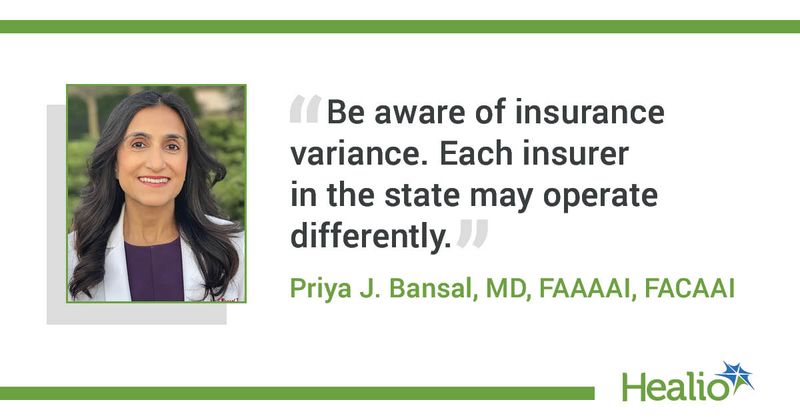Q&A: How to use ‘buy and bill’ for biologic treatment in allergy, asthma care
Key takeaways:
- Practices receive biologics directly and then bill the payer for their use.
- Advantages include improved compliance and control of the disease.
- Practices face risks when third parties do not pay for treatment.
As biologics become more popular for a growing number of indications, practices need to figure out the most cost-effective ways to provide these treatments to their patients.
Many practices are now using “buy and bill” to offer biologic care. Healio spoke with Priya J. Bansal, MD, FAAAAI, FACAAI, past chair of the American Academy of Allergy, Asthma & Immunology Practice Management Committee and Workshop and Healio Asthma and Allergy Peer Perspective Board Member, to find out more.

Healio: What is buy and bill when it comes to biologics?
Bansal: Buy and bill is a system where physicians’ offices receive the biologic in the office to be able to be administered to the patient. The physician’s office “buys” the drug and then “bills” the payer for the biologic.
Healio: What are the advantages of this approach?
Bansal: There are several advantages to this approach. First, it assists with compliance and control of the disease for which the biologic is being prescribed. Patients coming in for the biologic can be seen by the clinician if they are not doing as well. It allows the clinician some flexibility with dosing intervals and creates a supplemental revenue stream for the office. It also gives control over the supply chain. The office has visibility into the patient’s medication at all times to minimize biologic disruption. If the office partners with another company to assist with buy and bill, they may be able to get assistance with prior authorizations and minimize risk to the practice.
Healio: What are the disadvantages of this approach?
Bansal: Disadvantages are the large risk if the third party does not pay for the medication after it has been administered. Even with prior authorizations, claims are fought with the third-party payers, as biologics are expensive and may be denied for buy and bill. Patient insurance changes or lack of medication verification with the insurance can compound this issue.
Healio: Are there any differences for small practices vs. larger practices in adopting buy and bill?
Bansal: Smaller practices may not have the financial reserves to take the risk for buy and bill. They need to look into how much risk they are willing to take, and if they have the staff infrastructure to take on the project. Smaller practices also might not have the buying power to qualify for higher-level rebate structures based upon volume. Larger practices may also have an in-house pharmacy from which they can obtain medication more quickly.
Healio: Are there any differences in buy and bill programs to be aware of based on insurance providers?
Bansal: Be aware of insurance variance. Each insurer in the state may operate differently. Try to make sure approvals are in hand prior to administration of the product, and verify insurance and eligibility the morning of the biologic injection(s).
Healio: Would a buy and bill program be assigned to a specific person on your practice’s staff?
Bansal: Buy and bill should be taught to a specific staff member such as a biologic coordinator that oversees the whole program. However, the front desk may be assigned to verifying insurance, and other staff may be verifying, administering and charting the biologic.
Healio: How do you decide whether or not to use buy and bill for a particular patient?
Bansal: Engage in shared decision-making with your patient. Is their asthma uncontrolled? Does their asthma need in-clinic monitoring? Does the patient travel a lot and thus would have a hard time coming to the clinic for injections? Does the patient want a biologic that is administered more or less frequently? Is a particular biologic going to work better in that patient? All these thoughts play into making the best decision for the patient and for the practice.
Healio: Are there any other potential issues that practices should be aware of before initiating a buy and bill program?
Bansal: Many issues can come up with buy and bill. Decide for yourself how much risk you want to take. If you want full profit, that also involves full risk and full paperwork responsibilities. Some middle companies can alleviate the prior authorization, billing and verification burden, but do so at a substantial fee.
Also, make sure to have someone that is detail-oriented managing the program and navigating the office. The loss of one injection can amount to thousands of dollars lost to the practice. And if expectations are not clearly communicated to the patient or staff, that can lead to frustration on both ends. Some biologics are not available buy and bill, and those need to be navigated independently as well.
For more information:
Priya J. Bansal, MD, FAAAAI, FACAAI, can be reached at asthmaallergywellness@gmail.com.
